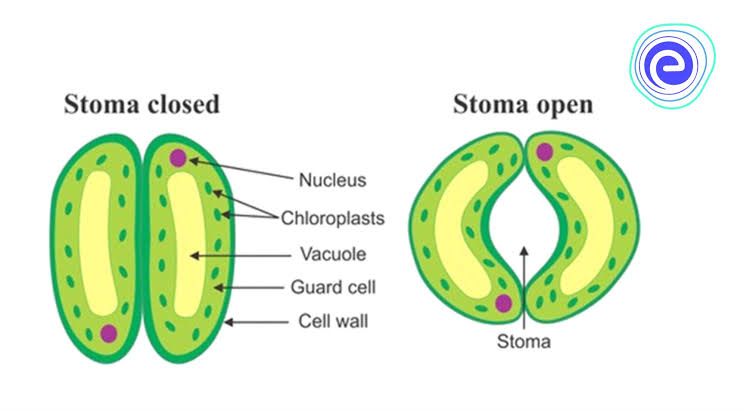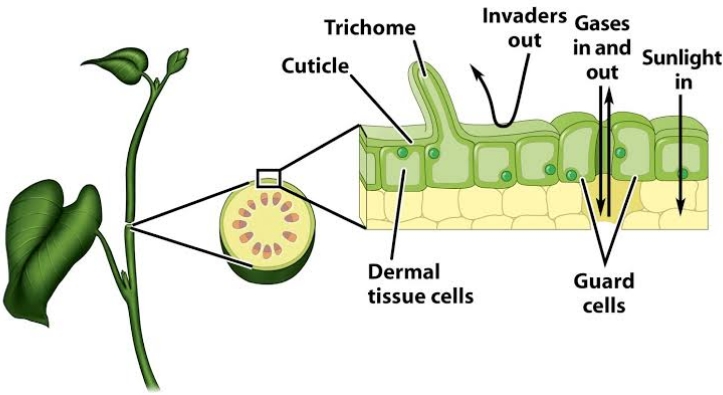Control The Openings Of The Gas Exchanging Pores İn The Dermal Tissue System. All details & answers are below. Good reading.
Control The Openings Of The Gas Exchanging Pores İn The Dermal Tissue System
Control The Openings Of The Gas Exchanging Pores İn The Dermal Tissue System: Control of gas exchange in the dermal tissue system is primarily through the regulation of stomata, the openings responsible for gas exchange. Stomata are located in the epidermis of leaves, stems and other plant organs. Of course, it also allows the passage of gases such as carbon dioxide, oxygen and water vapor.
The opening and closing of stomata is controlled by special cells called “guard cells”. The guard cells swell when they take in water. This leads to the opening of the stomatal pores. But on the contrary, if the guard cells lose water, they begin to sag and close the stomata.
Control The Openings Of The Gas Exchanging Pores İn The Dermal Tissue System: Environmental conditions, plant hormones and internal signals also play an important role in the opening and closing of stomata. Some of the important factors involved in stoma regulation are:

- Light:
Stomas often open in response to light. The light energy is captured by the chlorophyll in the mesophyll cells of the leaves. Of course, this triggers many physiological and molecular events that lead to the opening of stomata.
- Carbon dioxide (CO2) concentration:
When CO2 levels are lower than normal, plants open their stomata to facilitate CO2 uptake for photosynthesis. Conversely, when CO2 levels are high, stomata usually close partially to reduce water loss.
- Water availability:
The importance of the presence of water in stomatal arrangement is indisputable. It is undoubtedly very important. When water is plentiful, stomata tend to remain open, leading to increased gas exchange. Of course, when water is scarce, plants close their stomata to minimize water loss through transpiration.
- Hormones:
Plant hormones such as abscisic acid (ABA) have also been recorded as effective factors in stomatal regulation. ABA is produced in response to drought stress and other different environmental factors. Of course, it also helps to close stomata by minimizing water loss.
- Environmental factors:
Important environmental conditions such as temperature, humidity and air pollution also have an important place in stomatal movements! For example, high temperatures and low humidity often cause stomata to close to conserve water. Control The Openings Of The Gas Exchanging Pores İn The Dermal Tissue System is over.
What small pores in the dermal tissue system that allow for gas exchange?
Stomas are located in the dermal tissue. These are small pores surrounded by two guard cells. Stomata regulate the flow of gases into and out of the leaf, as well as the escape of water. Epidermal hairs and root hairs are among the adaptations of dermal tissue.
- What İs The Domain Of The Given Function? {(3, –2), (6, 1), (–1, 4), (5, 9), (–4, 0)}
- What İs The Domain Of The Square Root Function Graphed Below?
- Cross-cultural research stimulated by vygotsky’s sociocultural theory has shown that
- Which Of The Following Diseases Causes Damage To A Dog’s Nervous System?
- Pneumonia Oral Rehydration Therapy

 Number One Boats from USA. Boat Marketplace Group Network. All Boats & Yachts for Sale, Reviews, Specs, Prices, Craigslists.
Number One Boats from USA. Boat Marketplace Group Network. All Boats & Yachts for Sale, Reviews, Specs, Prices, Craigslists. 